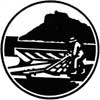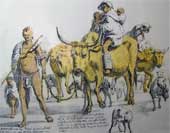The Khoikhoin
|
 |
Hout Bay Museum |
|
 The Khoikhoin were the people whom early exposures from Europe, from 1488 onwards, met along the southern coast of Africa. They called themselves the Khoikhoin (man of men). But because of a characteristic word or sound in their speech, which had many click sounds, they were called Hottentots by the early Dutch.
The Khoikhoin were the people whom early exposures from Europe, from 1488 onwards, met along the southern coast of Africa. They called themselves the Khoikhoin (man of men). But because of a characteristic word or sound in their speech, which had many click sounds, they were called Hottentots by the early Dutch.
The Khoikhoin belonged to the same racial group as the Khoi-San, and, like them were descendants of later Stone Age people. The were short and slight in stature, with small hands and feet, a soft skin which had a tendency to wrinkle early and curly hair which curled in tufts on the head. The women had a marked tendency to steatopygia, that is, the accumulation of fat on the buttocks.
The Khoikhoin, like the Khoi-San, were hunters and gatherers of wild foods, who grew no crops, whereas the Khoikhoin kept extensive herds of cattle and flocks of sheep. The Khoi-San herded no animals. Milk was an important part of the Khoikhoin’s diet.
The Khoikhoin were semi-nomadic, in that they moved about within a defined area, looking for grazing for their large herds of cattle and sheep. They often camped in Hout Bay and along the slopes of the Twelve Apostles. The names of Oudekraal and Hottentotshuisie remain to remind us of their early camps. The watermen, Strandlopers and Kaapmans that van Riebeeck often refers to in his diary were Khoikhoin.
|
|
|
|
Print this window
|
|

